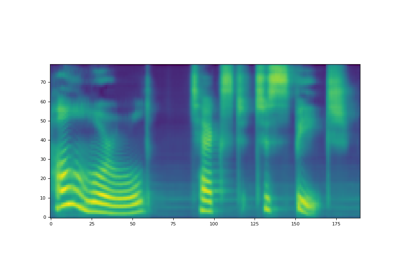Tacotron2¶
- class torchaudio.models.Tacotron2(mask_padding: bool = False, n_mels: int = 80, n_symbol: int = 148, n_frames_per_step: int = 1, symbol_embedding_dim: int = 512, encoder_embedding_dim: int = 512, encoder_n_convolution: int = 3, encoder_kernel_size: int = 5, decoder_rnn_dim: int = 1024, decoder_max_step: int = 2000, decoder_dropout: float = 0.1, decoder_early_stopping: bool = True, attention_rnn_dim: int = 1024, attention_hidden_dim: int = 128, attention_location_n_filter: int = 32, attention_location_kernel_size: int = 31, attention_dropout: float = 0.1, prenet_dim: int = 256, postnet_n_convolution: int = 5, postnet_kernel_size: int = 5, postnet_embedding_dim: int = 512, gate_threshold: float = 0.5)[source]¶
Tacotron2 模型,源自 Natural TTS Synthesis by Conditioning WaveNet on Mel Spectrogram Predictions [Shen 等人, 2018],基于 Nvidia Deep Learning Examples 的实现。
另请参阅
torchaudio.pipelines.Tacotron2TTSBundle: 带有预训练模型的 TTS 流水线。
- 参数:
mask_padding (bool, 可选) – 使用掩码填充 (默认值:
False)。n_mels (int, 可选) – Mel Bin 的数量 (默认值:
80)。n_symbol (int, 可选) – 输入文本的符号数量 (默认值:
148)。n_frames_per_step (int, 可选) – 每步处理的帧数,仅支持 1 (默认值:
1)。symbol_embedding_dim (int, 可选) – 输入嵌入维度 (默认值:
512)。encoder_n_convolution (int, 可选) – 编码器卷积层数量 (默认值:
3)。encoder_kernel_size (int, 可选) – 编码器核大小 (默认值:
5)。encoder_embedding_dim (int, 可选) – 编码器嵌入维度 (默认值:
512)。decoder_rnn_dim (int, 可选) – 解码器 LSTM 的单元数量 (默认值:
1024)。decoder_max_step (int, 可选) – 输出 Mel 谱图的最大数量 (默认值:
2000)。decoder_dropout (float, 可选) – 解码器 LSTM 的 Dropout 概率 (默认值:
0.1)。decoder_early_stopping (bool, 可选) – 在所有样本完成后继续解码 (默认值:
True)。attention_rnn_dim (int, 可选) – 注意力 LSTM 的单元数量 (默认值:
1024)。attention_hidden_dim (int, 可选) – 注意力隐藏表示的维度 (默认值:
128)。attention_location_n_filter (int, 可选) – 注意力模型的滤波器数量 (默认值:
32)。attention_location_kernel_size (int, 可选) – 注意力模型的核大小 (默认值:
31)。attention_dropout (float, 可选) – 注意力 LSTM 的 Dropout 概率 (默认值:
0.1)。prenet_dim (int, 可选) – Prenet 层中的 ReLU 单元数量 (默认值:
256)。postnet_n_convolution (int, 可选) – Postnet 卷积层数量 (默认值:
5)。postnet_kernel_size (int, 可选) – Postnet 核大小 (默认值:
5)。postnet_embedding_dim (int, 可选) – Postnet 嵌入维度 (默认值:
512)。gate_threshold (float, 可选) – 停止标记的概率阈值 (默认值:
0.5)。
- 使用
Tacotron2的教程
方法¶
forward¶
- Tacotron2.forward(tokens: Tensor, token_lengths: Tensor, mel_specgram: Tensor, mel_specgram_lengths: Tuple[Tensor]) Tuple[Tensor, Tensor, Tensor, Tensor][source]¶
将输入通过 Tacotron2 模型。这处于教师强制模式,通常用于训练。
输入
tokens应使用零填充至token_lengths的最大长度。输入mel_specgram应使用零填充至mel_specgram_lengths的最大长度。- 参数:
tokens (Tensor) – Tacotron2 的输入标记,形状为 (n_batch, max of token_lengths)。
token_lengths (Tensor) –
tokens中每个样本的有效长度,形状为 (n_batch, )。mel_specgram (Tensor) – 目标 Mel 谱图,形状为 (n_batch, n_mels, max of mel_specgram_lengths)。
mel_specgram_lengths (Tensor) – 每个 Mel 谱图的长度,形状为 (n_batch, )。
- 返回:
- Tensor
Postnet 之前的 Mel 谱图,形状为 (n_batch, n_mels, max of mel_specgram_lengths)。
- Tensor
Postnet 之后的 Mel 谱图,形状为 (n_batch, n_mels, max of mel_specgram_lengths)。
- Tensor
每个时间步的停止标记输出,形状为 (n_batch, max of mel_specgram_lengths)。
- Tensor
来自解码器的注意力权重序列,形状为 (n_batch, max of mel_specgram_lengths, max of token_lengths)。
- 返回类型:
[Tensor, Tensor, Tensor, Tensor]
infer¶
- Tacotron2.infer(tokens: Tensor, lengths: Optional[Tensor] = None) Tuple[Tensor, Tensor, Tensor][source]¶
使用 Tacotron2 进行推理。输入是一批编码后的句子 (
tokens) 及其对应的长度 (lengths)。输出是生成的 Mel 谱图、其对应的长度以及来自解码器的注意力权重。输入
tokens应使用零填充至lengths的最大长度。- 参数:
tokens (Tensor) – Tacotron2 的输入标记,形状为 (n_batch, max of lengths)。
lengths (Tensor 或 None, 可选) –
tokens中每个样本的有效长度,形状为 (n_batch, )。如果为None,则假定所有标记都有效。默认值:None
- 返回:
- Tensor
预测的 Mel 谱图,形状为 (n_batch, n_mels, max of mel_specgram_lengths)。
- Tensor
预测的 Mel 谱图的长度,形状为 (n_batch, )。
- Tensor
来自解码器的注意力权重序列,形状为 (n_batch, max of mel_specgram_lengths, max of lengths)。
- 返回类型:
(Tensor, Tensor, Tensor)

